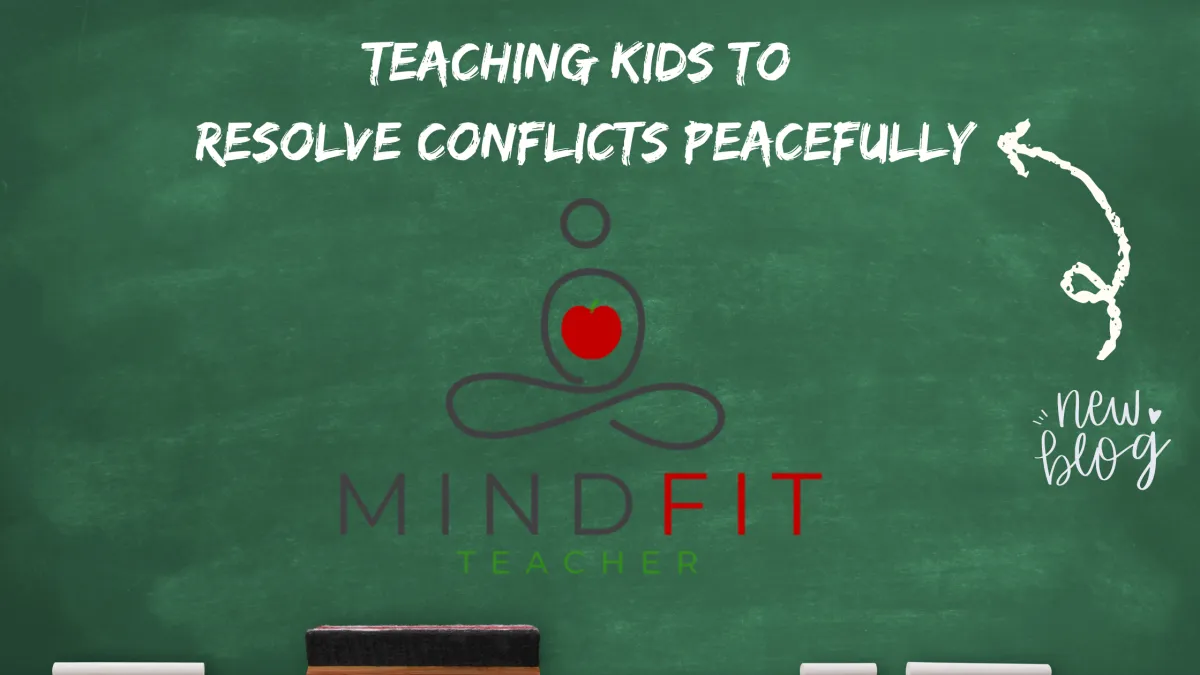
Peaceful Conflict Resolution for the Elementary Classroom

Teaching Kids to Resolve Conflicts Peacefully
Recess Snapshot: It's recess time, and two students, Alex and Josh, are playing a game of tag. In the heat of the moment, Alex accidentally pushes Josh, causing him to fall and scrape his knee. Josh is hurt and upset, and Alex feels bad but doesn't know how to make things right.
Alex: (giggling) "You’re it, Josh!"
Josh: (chasing after Alex) "Not for long!"
(As Alex turns quickly to dodge Josh, he accidentally pushes Josh. Josh falls and scrapes his knee.)
Josh: (shouting in pain) "Ow! That hurt! Why’d you push me?"
Alex: (looking panicked) "I didn’t mean to! It was an accident!"
Josh: (angrily) "Well, it still hurts! Now my knee is bleeding!"
Oh, boy! Both students are frustrated, and the situation could easily escalate into a bigger conflict.
After recess you, the teacher, spend precious instructional time mediating the students' conflict.
Been there, done that!
This scenario, among a laundry list of others I’m sure you could write a book on, is a perfect example of why teaching children how to resolve conflicts peacefully and apologize sincerely is essential.
These skills are crucial for their social-emotional development and help build a positive classroom community. Let's dive into why these topics matter and how you can effectively teach them.
Common Conflicts in Elementary School
Elementary students often encounter a variety of conflicts that can benefit from learning conflict resolution skills. Some common examples include:
Arguments over toys or playground equipment: "I was using that first!"
Disagreements during group work: "You’re not doing it right!"
Accidental physical harm: "You stepped on my foot!"
Hurtful words or teasing: "You're not my friend anymore!"
Exclusion from activities: "You can't play with us!"
Challenges to Peaceful Conflict Resolution and Apologizing
Despite the best intentions, children can face several challenges that make apologizing and resolving conflicts peacefully difficult:
Lack of Emotional Vocabulary: Children may struggle to express their feelings accurately.
Fear of Rejection: They might worry that their apology will not be accepted.
Pride and Embarrassment: Admitting mistakes can be hard for anyone, especially young children. Let’s be honest it’s pretty hard for some adults too.
Misunderstanding Intentions: Kids might misinterpret the actions or words of others, escalating conflicts.
Peer Pressure: Friends may encourage them not to apologize or back down from a conflict.
Peaceful Conflict Resolution

Conflicts are a natural part of life, especially in a classroom full of energetic kids. Teaching students how to resolve conflicts peacefully can transform your classroom into a more harmonious place. Here’s how to approach it:
What is Peaceful Conflict Resolution?
A way to express feelings and needs without blame or judgment.
Listening without feeling judged or criticized.
Practicing mindful listening and speaking.
Steps to Peaceful Conflict Resolution:
Observation: Describe what happened without interpreting or judging.
Feelings: Express how the situation made you feel.
Needs/Values: State what you need or value.
Request: Make a clear and specific request to resolve the issue.
Example of Peaceful Conflict Resolution:
Observation: "Alex, when we were playing tag, you pushed me and I fell."
Feelings: "It hurts."
Needs/Values: "I want us to have fun and not get hurt."
Request: "Can you please be more careful when we play?"
Activities to Support Conflict Resolution:
Discuss what peaceful communication looks, sounds, and feels like.
Anchor Chart: Display the 4 steps to guide students.
Role-Play: Practice scenarios with students.
Reflection: Encourage students to reflect on conflicts and how they resolved them.
Teaching Kids to Apologize and Mean It

We all make mistakes. It's part of growing up and being human. Teaching children to apologize sincerely is an important skill that helps them take responsibility for their actions and mend relationships. Here's a quick guide on how to introduce this concept to your students:
What is an Apology?
An apology is when we admit we made a mistake and take responsibility for our actions.
Why Apologize?
To show we understand our mistake.
To express that we care about the other person's feelings.
To start mending a damaged relationship.
Steps to a Sincere Apology:
Acknowledge the Mistake: Admit what you did wrong.
Take Responsibility: Own up to your actions without making excuses. Show that you understand how your actions affected the other person.
Make Amends: Offer to fix the mistake or make up for it.
Ask for Forgiveness/Promise to Change: Commit to not repeating the behavior.
Example of an Apology:
Alex: "Josh, I'm sorry I pushed you. I didn't mean to make you fall and get hurt. Can I help you get to the nurse? I'll be more careful next time we play. Please forgive me."
Activities to Reinforce Apologies:
Poster/Anchor Chart: Display the steps to remind students.
Apology Letter Templates: Provide structured templates for students to practice writing apologies. Some children express themselves better in writing.
Role-Play: Practice different apology scenarios.
Teacher Model: Demonstrate sincere apologies in real-time situations.
Why These Skills Matter
Building Trust and Respect:
Apologizing and resolving conflicts show sincerity and trustworthiness.
These skills strengthen relationships and improve the classroom environment.
Enhancing Social-Emotional Well-Being:
Helps students manage emotions and communicate effectively.
Prepares them for future interpersonal challenges.
Promoting Mindful Communication:
Encourages expressing feelings and needs thoughtfully.
Cultivates a compassionate and respectful classroom culture.
Final Thoughts
If you would like additional support teaching peaceful conflict resolution in your classroom you can check out my resources, Peaceful Conflict Resolution and A Sincere Apology by clicking on the picture.

Incorporating lessons on peaceful conflict resolution into your curriculum is a game-changer. It equips your students with the tools to navigate social interactions with empathy and responsibility.
Plus, it fosters a supportive and harmonious classroom atmosphere where everyone can thrive.
Yay, for that!
Happy teaching!
Be well,
Christine
